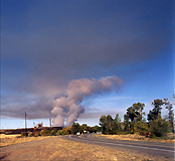|
Two Cases: Clear Air In Rockies
By Jenny Coyle
 Like a true Rocky Mountain man, Reed Zars describes Colorado's Mt. Zirkel Wilderness Area as a "lower-elevation range" because its peaks don't reach above 14,000 feet. Like a true Rocky Mountain man, Reed Zars describes Colorado's Mt. Zirkel Wilderness Area as a "lower-elevation range" because its peaks don't reach above 14,000 feet.
Even still, its ridges are capped with snow-encrusted crags (Mt. Zirkel itself is 12,180 feet) that transition to a sub-alpine, high-altitude coniferous forest, which in turn melts into oak, chokecherry and sagebrush as the mountains spill into the grassy plains in the valley.
"As Muir would say, it's sublime," said Zars.
Sublime, yes - and polluted. For years, the acidity of the snowpack in this 140,000-acre wilderness has tested higher than any of the other 200 federally monitored sites west of the Mississippi, and roughly two and a half times higher than any other high-altitude site in the state.
 The culprit? Fewer than 40 miles upwind of Mt. Zirkel, nestled in the Yampa Valley, are the coal-fired Craig and Hayden power plants, which account for virtually all of the area's emissions of sulfur and nitrogen oxides - the components of acid rain. The culprit? Fewer than 40 miles upwind of Mt. Zirkel, nestled in the Yampa Valley, are the coal-fired Craig and Hayden power plants, which account for virtually all of the area's emissions of sulfur and nitrogen oxides - the components of acid rain.
But two recent legal victories 10 years in the making are already serving to clean up this wilderness area's "worst in the West" reputation. Zars, an attorney based in Laramie, Wyo., worked with the Rocky Mountain (Colorado) Chapter and its Trapper Lake Group to win the cases.
First, in 1993, the Sierra Club sued the owners of the Hayden plant for more than 17,000 violations of its Clean Air Act permit. In order to pursue the case, the Club had to show "standing," or demonstrate that its members were personally impacted by the pollution.
Zars credits Joan Hoffmann, now a California resident, with organizing volunteers to testify. "I credit these people as much as anyone in bringing this suit around," said Zars. "It takes an awful lot of courage to stand up in your small community and be willing to bear the political heat of saying you've been impacted and care enough to put your name on the line. Many were harassed by the utilities' lawyers, but they stood firm."
In 1996, Hayden's owners were ordered to spend $130 million to upgrade the power plant, and pay $2 million in fines to the U.S. Treasury and another $2 million to environmental projects in the Yampa Valley.
The Club directed the money to purchase a conservation easement at the base of a proposed major ski resort complex that the Rocky Mountain Chapter had been fighting for years. This effectively ended the resort proposal - "a two for one deal," Zars called it.
"We also received $250,000 that was directed to the Routt County Board of Health to provide major rebates to residents converting from wood-stove heat to natural gas or propane," said Zars. "Hundreds of stoves were converted, and the valley's air became cleaner still."
Although Hayden's owners are also part owners of the nearby Craig generating station, and Zars figured they might voluntarily upgrade the second plant, the owners refused. So in 1996, the Sierra Club filed suit.
"This time they had a team of lawyers who'd learned from the Hayden case, plus they hired more lawyers, more expert witnesses and threw millions of dollars at the case trying to unravel what we obtained at Hayden," said Zars. For instance, Craig's attorneys immediately filed a motion to strike any references to the Hayden case, or to the fact that the Craig plant was polluting the Mt. Zirkel Wilderness. The motion was denied.
Again, the Sierra Club prevailed. In January 2001, Craig's owners were ordered to spend $160 million in pollution controls, $500,000 in penalties and $1.5 million into a renewable energy fund.
These cases set a legal precedent: Power-plant owners had argued in both cases that the Club shouldn't be permitted to use data from monitoring equipment on smokestacks at the plants, but the judge ruled against them. The ability of citizens to use stack monitoring against polluters now has nationwide application, thanks to federal regulations issued by the Environmental Protection Agency that relied heavily on the decision in Hayden. A growing number of Clean Air Act cases have also relied on the rulings in Hayden and Craig to the benefit of other pollution cleanups.
Said Alex Levinson, the Club's coordinating attorney, "Reed used the Clean Air Act to protect the air quality of an important wilderness area; he used the leverage of penalty fines to persuade the corporate polluter to clean up its plant far more substantially than the law requires; and then he used the remaining penalty monies to forge a settlement to stop a major ski development in the same valley."
In fact, officials in the six-state EPA Region 8 area have given Zars two awards for his work on the cases. The most recent, an "Environmental Achievement Award," was announced in August.
Award or not, Zars is pleased. "The new equipment is all on board at Hayden, and there's already a remarkable difference in the Yampa Valley," he said. "You used to be able to see a plume from the plant and a brown haze like the one you see over Denver. Now you can't tell whether the plant is operating by looking at the stacks - there are no visible emissions, and I haven't seen the haze since the cleanup." He expects similar results from the upgrades at the Craig plant.
Photo of power plant courtesy Reed Zars
Up to Top
|